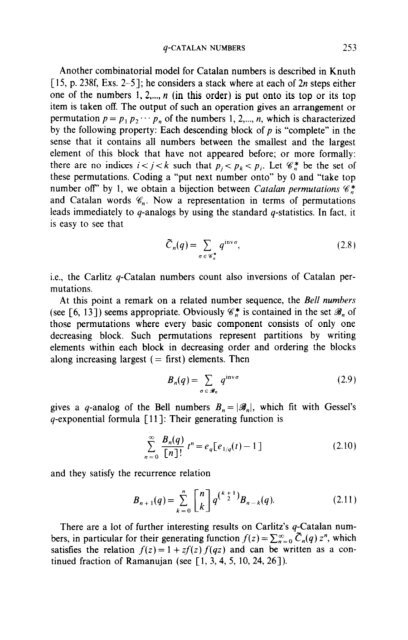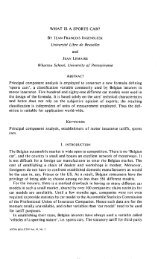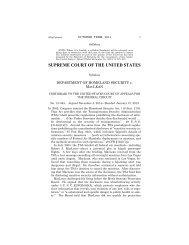85jct_catalan
Create successful ePaper yourself
Turn your PDF publications into a flip-book with our unique Google optimized e-Paper software.
(I-CATALAN NUMBERS 253<br />
Another combinatorial model for Catalan numbers is described in Knuth<br />
[ 15, p. 238f, Exs. 2-51; he considers a stack where at each of 2n steps either<br />
one of the numbers 1, 2,..., n (in this order) is put onto its top or its top<br />
item is taken off. The output of such an operation gives an arrangement or<br />
permutation p = p, pz.. . pn of the numbers 1, 2,..., n, which is characterized<br />
by the following property: Each descending block of p is “complete” in the<br />
sense that it contains all numbers between the smallest and the largest<br />
element of this block that have not appeared before; or more formally:<br />
there are no indices i < j< k such that pj < pk < pi. Let %‘z be the set of<br />
these permutations. Coding a “put next number onto” by 0 and “take top<br />
number off’ by 1, we obtain a bijection between Catalan permutations %?z<br />
and Catalan words %?,,. Now a representation in terms of permutations<br />
leads immediately to q-analogs by using the standard q-statistics. In fact. it<br />
is easy to see that<br />
chl)= c q’“‘“,<br />
OEV,*<br />
(2.8)<br />
i.e., the Carlitz q-Catalan numbers count also inversions of Catalan permutations.<br />
At this point a remark on a related number sequence, the Bell numbers<br />
(see [6, 131) seems appropriate. Obviously U,* is contained in the set 9Y,, of<br />
those permutations where every basic component consists of only one<br />
decreasing block. Such permutations represent partitions by writing<br />
elements within each block in decreasing order and ordering the blocks<br />
along increasing largest (= first) elements. Then<br />
B,,(q) = 1 qinvo (2.9)<br />
gives a q-analog of the Bell numbers B, = 1!-%,J, which lit with Gessel’s<br />
q-exponential formula [ 111: Their generating function is<br />
.:,g<br />
t”=e,[e,iu(t)- l]<br />
(2.10)<br />
and they satisfy the recurrence relation<br />
(2.11)<br />
There are a lot of further interesting results on Carlitz’s q-Catalan numbers,<br />
in particular for their generating function f(z) = C,“=O e,,(q) zn, which<br />
satisfies the relation f(z) = 1 + zf(z)f(qz) and can be written as a continued<br />
fraction of Ramanujan (see [ 1, 3, 4, 5, 10, 24, 261).





